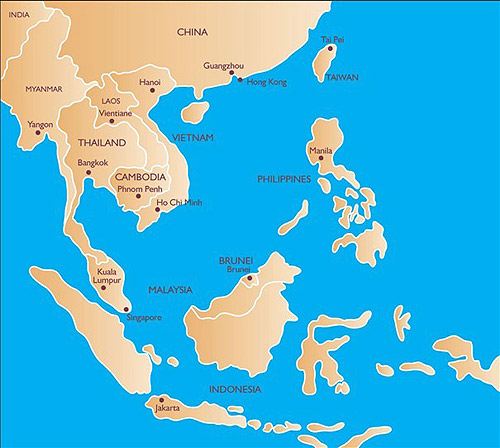Study: Nanning-Singapore Corridor to Boost Trade Ties
Adjust font size:
A shortcut connecting a population of 1.5 billion
 |
|
Map of Southeast Asia, provided by the Forum on China-ASEAN Free Trade Area |
The total GDP of the seven countries along the Nanning-Singapore Corridor amounts to US$5.2 trillion, with a population of 1.53 billion in 2008 (see table one).
Table one: Nanning-Singapore Corridor Countries’ Land Area, Population and GDP, 2008
|
Country |
Land Area (10,000 sq km) |
Population (10,000) |
GDP (US$0.1 billion) |
Per Capita GDP (US dollar) |
|
China |
960 |
132802 |
44020 |
3310 |
|
Vietnam |
32.96 |
8611 |
908 |
1055 |
|
Laos |
23.68 |
667 |
52 |
776 |
|
Thailand |
51.31 |
6549 |
2721 |
4155 |
|
Cambodia |
18.1 |
1424 |
108 |
760 |
|
Malaysia |
33.03 |
2527 |
2147 |
8496 |
|
Singapore |
0.0699 |
460 |
1928 |
41840 |
|
Total |
1119.1499 |
153040 |
51884 |
3390 |
Note: provided by the Forum on China-ASEAN Free Trade Area
Table two: Trade volume Between China and Indochina Peninsula Countries, 2008
|
|
Exports & imports (US$0.1 billion) |
Growth rate (%) |
Exports (US$0.1 billion) |
Imports (US$0.1 billion) |
|
Vietnam |
194.65 |
28.8 |
151.22 |
43.43 |
|
Laos |
4.15 |
57.5 |
2.68 |
1.47 |
|
Myanmar |
26.26 |
26.4 |
19.78 |
6.48 |
|
Thailand |
412.52 |
18.9 |
156.05 |
256.47 |
|
Cambodia |
11.33 |
21.3 |
10.94 |
0.39 |
|
Malaysia |
534.69 |
15.2 |
213.75 |
320.94 |
|
Singapore |
524.35 |
10.5 |
323.00 |
201.35 |
|
Total |
1707.95 |
|
|
|
Note: provided by the Forum on China-ASEAN Free Trade Area
The trade volume between China and Indochina Peninsula countries accounts for 74.9% of the total number between China and ASEAN countries (see table two). Therefore, building a multinational economic corridor has great significance. It will strengthen regional industrial cooperation on agriculture, tourism, transportation and services. Lu’s study also shows that the corridor will promote the efficient allocation of resources and production factors.
Better infrastructure urged
"After CAFTA begins operation, the transportation of cargo and passengers will increase sharply. Apart from developing sea transportation, the most important task is to build highways and high-speed railways that link China and ASEAN countries together,” Lu insisted.
“Better transportation and communication links will enable more efficient movement of goods, services and people between ASEAN and China, particularly to the less-developed states of ASEAN and areas in southwest China,” said Dato Abdul Majid, president of the Malaysia-China Friendship Association.
He added, “China’s participation in these sectors could act as a catalyst.”
(China Development Gateway written by Wei Bo, translated by Jiao Meng, January 16, 2010)